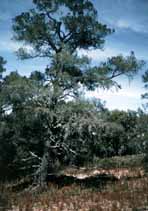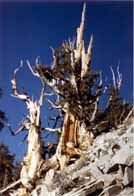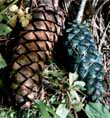Pinus contorta subsp. contorta growing in a peat bog on the Olympic Peninsula in Washington. This tree is common in bogs throughout its range [C.J. Earle].

Pinus cembroides var. lagunae Cerro Las Casitas, in the Sierra de la Laguna, BCS [C.J. Earle].

Pinus ponderosa subsp. scopulorum growing on sandstone, Zion National Park, Utah [C.J. Earle].

An exceptionally large individual of Pinus longaeva growing in the Schulman Grove, White Mountains, California/Nevada border [C.J. Earle]. This tree is at least several thousand years old.

Pinus lambertiana cones and needle fascicles [Dr. Linda B. Brubaker]. This species has the longest cones of any conifer (to 50 cm), although several pines have heavier cones.

Cones of Pinus armandii. Cone on left is about 25 cm long.

Specimen of Pinus palustris scarred for turpentine production. Bark was trimmed annually and sap collected and distilled to produce turpentine and pine tar. Exposed wood was charred during ground fires reinstated as a conservation practice, after turpentine production ceased [C.J. Earle].
Common Names
Pine, pinyon [English], pinho [Portugese], pino, piñon [Spanish], pino [Italian], pin, pignon [French], pijn, den [Dutch], Kiefer [German], fyr [Danish, Norwegian], tall [Swedish], mänty [Finnish], sosna [Russian], bor, mura [Bulgarian], bora, molike [Serbo-croat], peuke, pitys [Greek], çam [Turkish], chir, kail [Hindi], thong [Vietnamese], MATSU [Japanese], SONG [Chinese].Taxonomic notes
Syn: Apinus Necker; Strobus Opiz; Caryopitys Small; Ducampopinus A. Cheval. (Farjon 1998).The pine genus is the largest in the family, with about 110-120 species. Depending on taxonomic viewpoint, pines are divided into two or three subgenera. The two universally accepted subgenera are the typical pines in subgenus Pinus and the white pines in subgenus Strobus. One or more of the species in subgenus Strobus are in some classifications split off into a third subgenus Ducampopinus. Each of the subgenera can be further subdivided into a number of sections and subsections. Taking a broad view of subgenus Ducampopinus (Small, 1903 [as a genus]; Landry, 1974; Huxley et al. [eds.], 1992), the subgenera are distinguished by the following criteria (7):
Subgenus Pinus L. TYPICAL or HARD PINES. About 73 species. Cone scales with umbo dorsal and mucronate, scales with a sealing band adjacent to the apophysis where the scales meet on the closed cone. Seedwing articulate [easily separated from the seed] to weakly adnate [not easily separated]. Leaf vascular bundle double. Fascicles with 2-6 leaves, stomata more or less equally distributed on all surfaces; sheath mostly persistent.
Subgenus Ducampopinus (A. Cheval.) de Ferré ex Critchf. & Little (syn. genera Caryopitys Small; Ducampopinus A. Cheval.) PINYON, LACEBARK & FOXTAIL PINES. About 20 species. Cone scales with umbo dorsal and mucronate, scales without a sealing band. Seedwing articulate. Leaf vascular bundle single. Fascicles with 1-5 leaves, stomata all or most on inner faces, rarely equal; sheath deciduous to partly or fully persistent.
Subgenus Strobus Lemmon (syn. genera Apinus Necker; Strobus Opiz) WHITE or SOFT PINES. About 23 species. Cone scales with umbo terminal and not mucronate, scales without a sealing band. Seedwing strongly adnate. Leaf vascular bundle single. Fascicles with 5 leaves, stomata all or most on inner faces, rarely equal; sheath deciduous.
The genetic distance between the subgenera, at least between Pinus and Strobus, may be as large as or larger than that between e.g. Keteleeria Carrière, Cedrus Trew and Abies Miller (Price et al., 1987), and if strict genetic criteria were used they should perhaps be treated at generic rank. However, the pines as a whole form a clear monophyletic unit and retention as a single genus remains the best treatment. The nomenclatural upheaval of splitting the genus would also be a serious problem. Of the subgenera, Strobus is uniform with only small morphological differences, while Pinus is more variable as well as being larger. Ducampopinus as circumscribed above shows the greatest morphological differentiation despite its small number of species; many show relictual distributions and its species have been regarded by some as ancestral to the rest of Pinus (e.g. Farjon, 1984; Klaus, 1989). (8).
Much work is being done with problematic taxa. Considerable chemotaxonomic and genetic data are available on the genus, but coverage is far from comprehensive (1, 7).
A recent subdivision of the genus is (6) [with a few amendments]:
| Subgenus Pinus | |
|---|---|
| Section Pinus, Subsection Pinus | P. densata, P. densiflora, P. heldreichii, P. hwangshanensis, P. kesiya, P. luchuensis, P. massoniana, P. mugo, P. nigra, P. resinosa, P. sylvestris, P. tabuliformis, P. thunbergii, P. tropicalis, P. yunnanensis |
| Section Pinea, Subsection Pinaster Loudon | P. brutia, P. canariensis, P. halepensis, P. latteri, P. merkusii, P. pinaster, P. roxburghii |
| Section Pinea, Subsection Pineae Little & Critchfield | P. pinea |
| Section Trifoliis, Subsection Contortae Little & Critchfield | P. banksiana, P. contorta |
| Section Trifoliis, Subsection Australes Loudon | P. caribaea, P. clausa, P. cubensis, P. echinata, P. elliottii, P. glabra,P. occidentalis, P. palustris, P. pungens, P. rigida, P. serotina, P. taeda, P. virginiana |
| Section Trifoliis, Subsection Ponderosae Loudon | 'Sabinianae Group': P. coulteri, P. sabiniana, P. torreyana 'Ponderosa Group': P. arizonica, P. durangensis, P. engelmannii, P. jeffreyi, P. ponderosa, P. washoensis 'Montezumae Group': P. devoniana, P. hartwegii, P. montezumae 'Pseudostrobus Group': P. douglasiana, P. maximinoi, P. pseudostrobus |
| Section Trifoliis, Subsection Oocarpae Little & Critchfield | 'Attenuata Group': P. attenuata, P. muricata, P. radiata 'Oocarpa Group': P. greggii, P. jaliscana, P. oocarpa, P. patula,P. praetermissa, P. pringlei, P. tecunumanii 'Teocote Group': P. herrerae, P. lawsonii, P. teocote |
| Section Trifoliis, Subsection Leiophyllae Loudon | P. leiophylla, P. lumholtzii |
| Subgenus Ducampopinus | |
| Section Ducampopinus, Subsection Krempfianae Little & Critchfield | P. krempfii |
| Section Gerardiana, Subsection Gerardianae Loudon | P. bungeana, P. gerardiana, P.squamata |
| Section Parryana, Subsection Nelsoniae Van der Burgh | P. nelsonii |
| Section Parryana, Subsection Rzedowskianae Carvajal | P. maximartinezii, P. pinceana, P. rzedowskii |
| Section Parryana, Subsection Cembroides Engelmann | P. cembroides, P. culminicola, P. discolor, P. edulis, P. johannis,P. juarezensis, P. monophylla, P. orizabensis, P.remota |
| Section Parryana, Subsection Balfourianae Engelmann | P. aristata, P. balfouriana, P. longaeva |
| Subgenus Strobus | |
| Section Strobus, Subsection Strobi Loudon | P. amamiana, P. armandii, P. ayacahuite, P. bhutanica, P. chiapensis, P. dalatensis, P. fenzeliana, P. flexilis, P. lambertiana, P. monticola,P. morrisonicola, P. parviflora, P. peuce, P. pumila, P. strobiformis, P. strobus, P. wallichiana,P. wangii |
| Section Strobus, Subsection Cembrae Loudon | P. albicaulis, P. cembra, P. koraiensis, P. sibirica |
Description
Trees or shrubs, aromatic, evergreen; crown usually conic when young, often rounded or flat-topped with age. Bark of older stems variously furrowed and plated, plates and/or ridges layered or scaly. Branches usually in pseudowhorls; shoots dimorphic with long shoots and dwarf shoots; dwarf shoots borne in close spirals from axils of scaly bracts and bearing fascicles of leaves (needles). Branchlets stout, ending in a compound bud with many bud scales. Buds ovoid to cylindric, apex pointed (blunt), usually resinous. Leaves dimorphic, spirally arranged; foliage leaves (needles) (1)2-5(6) per fascicle, persisting 2-12 or more years, terete or ± 2-3-angled and rounded on abaxial surface, sessile, sheathed at base by 12-15 overlapping scale leaves, these (at least firmer basal ones) persisting for life of fascicle or shed after first season; resin canals mostly 2 or more (rarely 0-1; max. c. 20). Plants monoecious (rarely semi-dioecious); staminate cones numerous and small, in a dense, spikelike cluster around base of current year's growth, mostly ovoid to cylindric-conic, tan to yellow, red, blue, or lavender. Ovulate cones solitary to few, maturing in 1.5-2(-3) years, shed early or variously persistent, pendent to ± erect, at maturity conic or cylindric, sessile or stalked, shedding seed soon after maturity or variously serotinous (not opening upon maturity but much later, usually in response to fire); scales numerous, persistent, woody or pliable, surface of exposed apical portion of each scale (apophysis) thickened, with umbo (exposed scale surface of young cone) represented by a scar (sometimes apiculate) or extended into a hook, spur, claw, or prickle; bracts included. Two seeds at the base of the cone scale, winged, in some the wing vestigial; cotyledons (3)6-14(24). x=12 (1, 5).Range
Native to all continents and some oceanic islands of the northern hemisphere, chiefly in boreal, temperate, or mountainous tropical regions; reaching its southernmost distribution shortly below the Equator in southeast Asia (Sumatra). Introduced as ornamental and timber trees in much of the southern hemisphere (1, 2).Big Tree
For stem volume, diameter and height, the record holder is Pinus lambertiana.Oldest
Pinus longaeva. Due to their occurrence in some very cold and dry environments where disease and stand-destroying disturbance are rare, pines are collectively the most long-lived of conifers. Ages of over 1000 years have been encountered in P. albicaulis, P. aristata, P. balfouriana, P. flexilis, and P. longaeva, all species native to western North America, and comparable ages may occur in several Old World species native to desert, arctic and alpine areas.Dendrochronology
The science of dendrochronology originated with observations of Pinus ponderosa rings by astronomer Andrew Ellicott Douglas during travels in northern Arizona in 1904. Ever since then, pines have been preferred subjects for dendrochronology. Douglas used tree rings to date the construction of Anasazi ruins in the American Southwest, many workers have used scores of different pines to reconstruct past variations in climate, geochronologists have used pines to determine changes in the rate of atmospheric carbon-14 production over the past 7,000 years, and the rings of pines have been used to address a wide spectrum of other technical problems; for example, the tree-ring pattern in a pine board proved to be a crucial piece of evidence helping to convict the killer of the kidnapped Lindberg baby in 1923 (before O.J. Simpson, perhaps the most celebrated American trial of the 20th century).Ethnobotany
Pines are economically important for their timber, pulp, tar, and turpentine. When the world was tied together by sail, pines often assumed strategic importance as naval stores, thereby influencing patterns of Western colonialism. They were the first timber resource exploited in much of North America. They have long been a principal source of timber for all purposes, including firewood, construction and woodworking. They continue to be a leading genus in agroforestry production, dominating plantations in the U.K. (P. contorta, P. nigra), New Zealand (P. radiata) and Brazil (P. elliottii). Stone pines have an edible seed gathered by indigenous peoples (and sometimes commercially) and often comprising a major seasonal food source. Pines are also popular ornamentals.Observations
Comparative study of members of the genus is most easily accomplished at large arboreta; some are listed at the Links page.Remarks
Pinus was the Roman name for pine.In many areas Pinus is a forest dominant, either early successional or longer-lived, persisting in the late successional forest. Certain fire successional species, have a "grass stage," i.e., the stem of the young seedling elongates little during the first several years (meanwhile developing a large taproot) and bears many long, curved leaves, the plant then resembling a bunchgrass (1). Other species have cones that are long persistent and remain closed, opening only when heated by wildfire; seeds are released soon after, once the fire is out.
Most pines are fire-adapted, meaning that the recurrence of fire permits pines to maintain a dominant role in forest successions that lead to dominance by non-pines. The precise nature of this fire adaptation varies widely, with some pines tolerant of frequent low-intensity fires and others tending to produce high fuel accumulations that permit stand-destroying fires, after which the pines regenerate quickly. In habitats with infrequent or no fire, pines tend to occur either on extremely poor sites such as serpentine barrens or lithosols, or on extremely wet sites such as bogs. Their low shade tolerance typically precludes growth beneath a closed forest canopy. Many species are very drought tolerant.
A range map has been published for the genus, many of its subsections and most of its species in (3).
Many of the pines described here may be found with detailed descriptions and line drawings in Volume 1 of the Flora of North America (1), which offers the following caveats:
- Stated leaf measurements are based on healthy, fully expanded growth, especially that of cone-bearing branches.
- Fascicle-sheath measurements are based on fully developed, unbroken sheaths, not on sheaths as they later break up.
- After pollen is shed, pollen cones may lengthen considerably. Measurements given for pollen cones are those of the cones at the time that pollen is released.
- Colors of seed cones are those of mature, closed or newly opened cones, not of old, open, persistent cones or of weathered serotinous cones. Mature, open cones may be hygroscopic, closing partially or completely when wet.
- Descriptions of apophyses are based on mature, closed or newly opened cones. Unlike characters of umbos of most species, characters of apophyses are much altered as the cone grows.
- The term "twig" refers to growth of the current season.
- Leaf dimorphism is a problem. In some species, for example, low rainfall and beyond-normal stresses in the environment can lead to sets of atypically short leaves. There are also pathologic abnormalities, e.g., "little-leaf" disease in Pinus echinata. Such responses are not accounted for.
Citations
(1) Kral in Flora of North America online.(2) Mirov 1967.
(3) Critchfield & Little 1966.
(4) Perry 1991.
(5) Little 1980.
(6) Price et al. 1998.
(7) Richardson 1998.
(8) M.P. Frankis 1999 (in press).
Mirov (2) is the recognized "bible" of pines, while Mirov & Hasbrouck offer a more readable introduction to the genus.
Excellent pine drawings can be found in Sudworth (1908) and Shaw (1909, 1914), though their taxonomy is inevitably very dated.
See also:
Bailey, D.K. 1970. Phytogeography and taxonomy of Pinus subsection Balfourianae. Annals of the Missouri Botanical Garden 57: 210-249.
Bailey, D.K. 1987. A study of Pinus subsection Cembroides I: The single-needle Piñons of the Californias and the Great Basin. Notes of the Royal Botanical Gardens Edinburgh 44:275-310.
Bailey, D.K. and F.G. Hawksworth. 1979. Piñons of the Chihuahuan Desert region. Phytologia 44:129-133.
Duffield, J.W. 1952. Relationships and species hybridization in the genus Pinus. Silvae Genetica 1: 93-97.
Farjon, Aljos. 1984. Pines: drawings and descriptions of the genus Pinus. Leiden: Brill & Backhuys [Outstanding pen-and-ink drawings of nearly all species, with range maps, useful commentary, and some interesting cladistic diagrams].
Fowells, H.A. 1965. Silvics of forest trees of the United States. Washington: U.S.D.A. Agricultural Handbook 271.
Kurz, H. and R.K. Godfrey. 1962. Trees of northern Florida. Gainesville.
Little, E.L. Jr. and W.B. Critchfield. 1969. Subdivisions of the genus Pinus (pines). Washington. [U.S.D.A., Misc. Publ. 1144.]
Preston, R.J. 1976. North American Trees (Exclusive of Mexico and Tropical United States), ed. 3.
Price, R.A. 1989. The genera of Pinaceae in the southeastern United States. J. Arnold Arbor. 70: 247-305.
Richardson 1998 (highly recommended for its ecological information).
Sargent, C.S. 1922. Manual of the Trees of North America (Exclusive of Mexico), ed. 2. Boston and New York. [Facsimile edition in 2 vols. 1961, reprinted 1965, New York.]
Shaw, G.R. 1914. The Genus Pinus. Cambridge, Mass. [Publ. Arnold Arbor. 5.]
Sudworth, G.B. 1908. Forest Trees of the Pacific Slope. Washington.
Sudworth, G.B. 1917. The Pine Trees of the Rocky Mountain Region. Washington. [U.S.D.A. Bull. 460.]
back | Pinus | Pinaceae | home
This page is from the Gymnosperm Database
URL: http://www.geocities.com/~earlecj/pi/pin/index.htm
Edited by Christopher J. Earle
E-mail:earlecj@earthlink.com
Last modified on 15-Aug-1999
